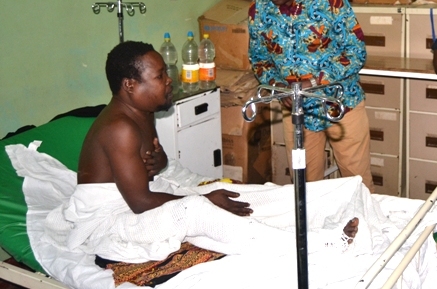By Memory Chatonda

BLANTYRE, August 24 Mana: Forty year-old Khama Samalani from Traditional Authority Mazengela’s area in Lilongwe took solace in various bottled energy giving drinks at work to stay awake.
Without knowing, he says: “The more sugar I consumed, the more I was hurting myself. I kept at it for years such that what looked like a sleep remedy became a daily routine.
“So, I would take an energy drink but 10 minutes later, I would have the urge to pee. In addition, I would have excessive thirst.”
Samalani, who was working at one of the Casinos in Lilongwe, remembers how a night experience ended in a diabetes diagnosis.
“One night at work, my vision got blurry such that I could barely see across the Casino floor.
“This, forced me to seek medical attention at Kamuzu Central Hospital where a blood test showed that blood sugar was beyond the imaginable,” he says.
According to Samalani, the levels had spiked over 600 milligrams per decilitre (mg/dl), far beyond the normal level which ranges between 70 to 140 mg/dl.
Samalani’s situation, according to the International Diabetes Federation, is not as unique. In fact, the Federation estimates in its 2021 National Diabetes Statistics Report indicates that the number of people that have suffered diabetes but are unaware that they have the disease are in millions.
“That was the beginning of my battle with diabetes. I remained at the hospital until the doctor brought my blood sugar level back with an Insulin injection,” Samalani says.
The International Diabetes Federation (IDF) says 537 million people between the ages 20 to 79 have diabetes across the globe. This represents a 16 percent rise from the previous IDF estimates in 2019.
In its 10th edition published in 2021, IDF says out of the estimated figures, the majority of them live in middle and low-income countries like Malawi.
According to Samalani, his Body Mass Index (BMI) was 105 kilogram and he could wear an extremely large pair of trousers.
This, he says was undoubtedly because of the too many sugars he was taking which in turn lead to frequent urination.
Diabetes, according to the World Health Organization (WHO) is a serious, chronic condition that affects lives and well-being of people at different stages. It is characterized by excess levels of sugar in the blood.
WHO says Type 1 diabetes often begins from childhood when the pancreas is damaged making it unable to produce insulin responsible for regulating the blood sugar level.
While Type 2 diabetes occurs mostly in adults of age between 20 to 79. This occurs when the pancreas produces insulin which is either insufficient or not good for the body cells to use it.
Gestational diabetes, lastly, is referred to as a high blood sugar level that appears only during pregnancy and it usually goes away after delivery.
WHO says Type 2 diabetes accounts for about 90 percent of all diabetes cases across the globe and it is the major cause of blindness, kidney failure, heart attacks, stroke, hypertension and lower limb amputation.
Global Burden of Disease Study also considers diabetes as the fifth leading cause of deaths. Others ahead of it being stroke, heart disease, congenital birth defects and chronic liver diseases.

Ministry of Health Spokesperson Adrian Chikumbe says Malawi just like any other countries is not spared from Diabetes which is one of the common non communicable diseases.
He says District Health Information System (DHIS) 2 of 2021 which is used for reporting, analyzing and disseminating data for all health programs established that a total of 20 per 100,000 people are diagnosed with diabetes annually in Malawi.
“However, there are more people that are diagnosed but, in some facilities, do not report. This in turn displays challenges in diagnosis of diabetes.
“Furthermore, private hospitals, Christian Health Association of Malawi facilities and other entities do not report in the DHIS2, thereby affecting the number of people per 100,000 that are diagnosed with diabetes,” he emphasizes
He then encourages people of age between 18 to 65 to regularly go for testing of Diabetes at their nearest health facilities to know their status.
“…of course, some of the noticeable symptoms include excessive thirst, frequent urination, weight loss and excessive hunger,” he highlights.
Diabetes Specialist who owns Alidziwa Health Private Clinic Dr Chilungamo Chingwanda says diabetes is a manageable condition if drug compliance, lifestyle modification and physical exercise are followed.
“It is better to start now making lifestyle changes, including losing weight, doing regular exercise, and avoiding processed foods as much as possible.
” It is advisable to eat lighter starches at night like boiled potatoes or reduce the quantity of nsima at night. It is also good not to eat so late at night like after 8pm,” says Chingwanda
Chingwanda who is also a lecturer at Kamuzu University of Health Sciences (KUHES) says failure to comply with diabetes treatment and lifestyle advice may lead to complications such as strokes, heart attacks, hypertension, nerve damage, sexual dysfunction, blindness and kidney failure among others.
Diabetes Association of Malawi President Clement Mandala therefore says the Association will continue intensifying mass sensitization campaigns to raise awareness about the disease especially on healthy lifestyle and also importance of early diagnosis.
“So far, more people are getting aware of the disease especially in the urban areas. However, some people still come after suffering from the symptoms for a few months.
” From talking to them you see that they suspected they may have had the disease but were in denial or were just afraid to know definitively what it was,” he says.
He adds that the Association will also continue working with the Ministry of Health to advocate for the better care for diabetic patients in Health facilities.
With collaborative efforts to wage war against diabetes, cases of diabetes could be reduced if not, IDF prediction of having the global prevalence of diabetic patients like Samalani at 643 million by 2030 and 783 million by 2045 will surely come to pass.


